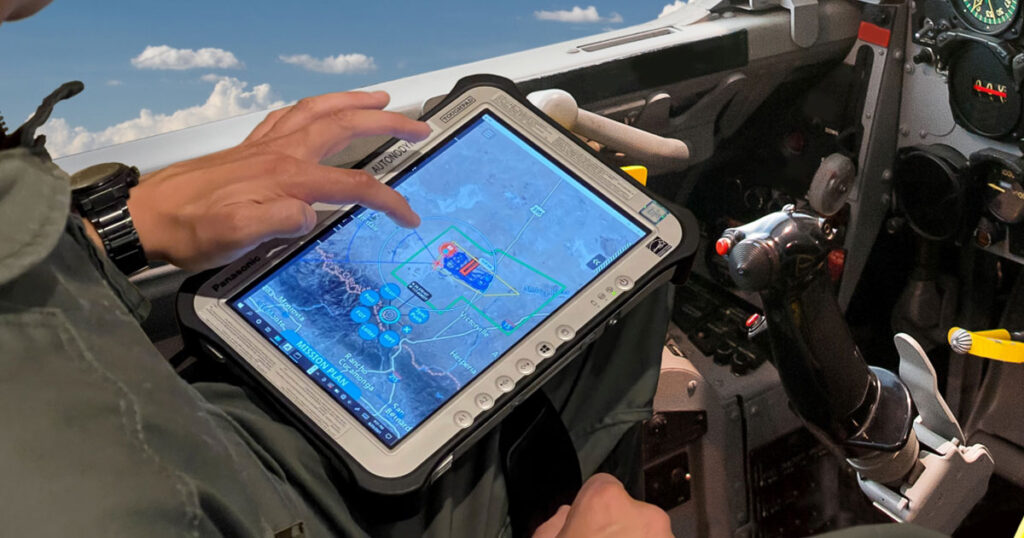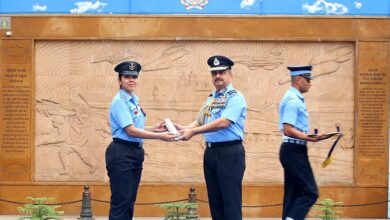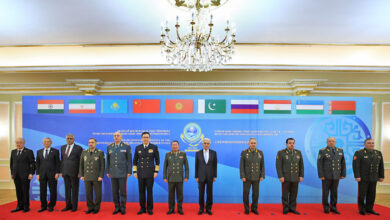Manned, Unmanned Teaming in Combat Air Systems: Revolutionizing Contemporary Warfare
By Gp Capt (Dr) Dinesh Kumar Pandey
New Delhi. The Indian Air Force is working towards Manned-Unmanned Teaming (MUM-T), envisaging a fighter aircraft being accompanied by three or more Unarmed Wingmen to engage high value targets.

Involved naturally is HAL, which is working with IAF to develop the Unmanned systems that will help a pilot extend the range and scope of his mission and deploy sophisticated sensors or weapons onboard his unmanned wingmen. Software to coordinate the Teaming may be sourced from private IT companies, which are now being encouraged to participate in defence modernisation by the Ministry of Defence (MOD). Some effort is already on in this perspective.
As a military concept, MUM-T operations are being adopted by various countries, and there is use in the ongoing Ukraine war. With this, besides extending the range of a mission, the Unmanned systems provide additional sensors and weapons, and help accomplish tasks that are otherwise too risky for a pilot.
What is MUM-T?
MUM-T is a concept that entails the coordinated use of soldiers, manned and unmanned air and ground vehicles, robots, and sensors to achieve situational awareness, enhanced lethality, and enhanced survivability. MUM-T is a deep penetration attack system.
It enhances quick and appropriate decision-making abilities and mission effectiveness, offering new tactical chances that could make a difference in the development of future strategies. In simple terms, MUM-T offers an interface between ground forces, manned aircraft, and Unmanned Aerial Systems.
MUM-T has several possible applications, such as the following missions and tasks:
Intelligence, Surveillance, and Reconnaissance (ISR): Without endangering human lives, unmanned systems can collect data on the enemy and assist the manned team in air and on ground.
Combat Potential: For manned systems to engage in combat, unmanned systems must first locate and track their targets.
Target acquisition: When manned systems have identified a target, they can also use unmanned systems to fire weapons at the target.
Resupply: In faraway places, unmanned systems can bring much-needed supplies to manned ones.
MUM-T v/s Traditional Military Ops
MUM-T has many benefits over conventional military operations, and the Indian armed forces are appropriately on the job.
First and foremost, it has the potential to reduce the danger to people significantly. Missions that would be too dangerous for human operators are perfect for unmanned systems. Second, MUM-T can enhance situational awareness. Intelligence from both manned and unmanned components can be shared with commanders to improve their perception of the battlefield. Third, MUM-T can make things more adaptable. Combinations of manned and unmanned technologies allow commanders to organise their troops to meet the requirements of any given mission.
Although MUM-T is still in its infancy, it has the potential to alter the nature of warfare completely. Armed forces can benefit from MUM-T because it combines the advantages of manned and unmanned aircraft, giving them more tools to prevent aggression, deal with crises, and safeguard national interests.
Benefits of MUM-T
A deeper awareness of the battlefield is possible when manned aircraft use unmanned aircraft to increase their range and endurance.
Enhanced Lethality: Unmanned aircraft can carry out strikes on heavily protected targets, which would be too risky for manned aircraft to attempt. Therefore, significantly contributes in MUMT mission accomplishments.
Higher survivability: Unmanned aircraft are more affordable and much simpler to replace than manned aircraft, which can help to reduce the risk of fatalities.
Although MUM-T has not yet reached its full potential, even at this early stage, it can completely alter the nature of the battle. MUM-T will become a more vital weapon system when the development of technology allows for greater integration.
The US Army for instance intends to test Rafael Spike Non-Line of Sight (NLOS) guided missiles with the AH-64E to further improve its capabilities. Attack helicopters equipped with such weapons might considerably benefit from UAS interoperability, as they could fire from ranges of up to 30 km.
There are several MUM-T systems in operation or in development, and the technology is progressing quickly. The following are examples of well-known MUM-T systems:
a) The U.S. Air Force’s MQ-9 Reaper and MQ-1 Predator drones, which can be controlled by a manned aircraft or by a ground control station or flown autonomously.
b) The U.S. Navy’s MQ-8B Fire Scout drone can be controlled by a manned helicopter or by a ground control station. It can be used to provide real-time video and sensor data to manned aircraft, or to carry out tasks such as search and rescue.
c) The U.K.’s Watchkeeper WK450 drone can be controlled by a manned aircraft or by a ground control station.
d) The Israeli Air Force’s Heron TP drone, which is a fully autonomous unmanned aircraft that can carry out a variety of missions, including surveillance, reconnaissance, and attack.
Global MUM-T Initiatives
In view of versatility of the MUM-T, various Air Forces are developing the system. The United States Air Force, along with those in Europe, the Middle East, UAE, and Australia, are just some of the many air forces actively researching, experimenting, and planning to acquire such capabilities. The United States has made significant progress in developing MUM-T capabilities, albeit this is a partial list. Since 2017 it introduced MUM-T capabilities with its export-oriented PREDATOR XP drone; General Atomics Aeronautical Systems (GA-ASI), maker of the MQ-9 REAPER, has promoted this feature for the worldwide market. Increased survivability for manned platforms, faster target engagement with extended range engagements, and more effective battle command based on up-to-date information collected via drones were all highlighted in GA-ASI’s marketing.
MUM-T in India
Hindustan Aeronautics Limited (HAL), in collaboration with private sector players, is creating India’s own MUM-T system, which it calls the “HAL Combat Air Teaming System (CATS)”.
CATS is an umbrella system with an LCA-based mother ship. The two-seater Tejas Mk1 Trainer will be the “Mothership for Air teaming eXploitation” (MAX). To fulfil its role as a MAX in CATS, the Tejas Mk-1A is undergoing upgrades to its command-and-control systems. Each LCA’s UAS/swarm drone will be controlled by Tejas MAX’s weapon system operator. The CATS will connect a network of advanced autonomous drones to a fighter aircraft, which will use them for air-to-air, air-to-sea, and air-to-ground combat. The Tejas twin-seat trainer is being perfected as part of a manned-unmanned teaming idea.
The vital elements of CATS are:
CATS Warrior: HAL and the private sector are developing the CATS Warrior, India’s own ‘Warrior’ drone. CATS Warrior is an unmanned wingman that can be piloted from CATS MAX and has a low profile. An upgraded variant of the HAL PTAE-7, a twin turbojet engine configuration formerly utilised in the DRDO Lakshya, would power the CATS Warrior. CATS Warrior can carry two MBDA advanced short-range air-to-air missile (ASRAAM), also known as the New Generation Close Combat Missile (NGCCM) in IAF service. A full-scale mock-up was exhibited at the Aero India-2023 show in Bengaluru. The range of NGCCM is up to 25 km.
CATS Hunter: The Hunter cruise missile are examples of the Combat Air Teaming System on show at Aero India 2021. CATS Hunter, which will have a range of 200 kilometres, is now in development.
CATS ALFA-S: Advances in air launched swarm Technology, HAL is collaborating with New Space Research & Technologies, a Bengaluru-based startup, to create an unmanned aerial vehicle called “Air Launched Flexible Asset-Swarm” (ALFA-S). As part of the ‘Jaguar Max’ update package revealed in 2019, ALFA-S was introduced as a swarm drone system capable of zeroing in on numerous targets. The trustworthy unmanned wingman can be outfitted with both air and ground missiles. The ALFA-S drones are packed inside CATS ALFA carrier. This is a glide pod, LCA can carry maximum 5 CATS ALFA glide pod. The first ALFA-S drone prototypes are likely to be deployed from Hawk Advanced Jet Trainers (AJTs).
CATS Infinity: Launched as an aerial control vehicle, the ‘CATS Infinity’, a High-altitude platform station (HAPS) can remain in orbit for an extended period (three to six months). This system is solar-powered pseudo-satellite. Solar energy sets it apart from existing combat air teaming systems. Its massive wings may be folded out to reveal solar panels. It will relay battlefield footage to satellites to facilitate communication amongst unmanned aerial vehicles.
The system will consist of a manned fighter aircraft acting as a “mothership” of the system and a set of swarming UAVs and UCAVs governed by the mothership aircraft.
According to HAL test pilot Group Captain HV Thakur (Retd), work on CATS began in the second part of 2018 and will pick up speed in late 2019/early 2020. The initial design phase is accomplished. However, there is room for expansion. HAL anticipates that all project-related development work will be finished by 2024 or 2025.
Conclusion
Future MUM-T operations will be propelled to new heights by the increasing autonomy of unmanned systems made possible by Artificial Intelligence and mission automation advances. India has already made good headway in AI, and some capabilities have been demonstrated by newly evolved Startups.
Swarms or flocks of UAVs will become more common, making it crucial for individual drones to be able to receive, collaborate on, and complete mission directives without direct human supervision. Future militaries may employ this tactic to maximise combat effectiveness with little personnel, to shield soldiers from harm, and to redirect mental and physical resources to mission command.





